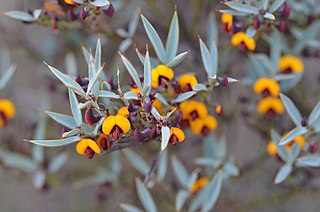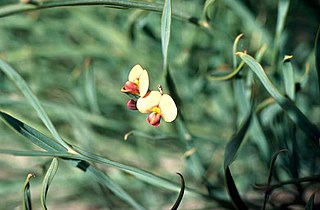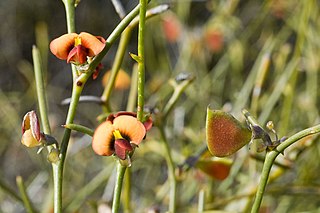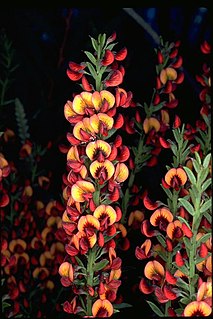
Daviesia nudiflora is a species of flowering plant in the family Fabaceae and is endemic to the south-west of Western Australia. It is a bushy shrub with sharply pointed, egg-shaped to elliptic or oblong phyllodes, and yellow-orange flowers with reddish-brown markings.

Daviesia hakeoides is a species of flowering plant in the family Fabaceae and is endemic to the south-west of Western Australia. It is a shrub with many tangled stems, scattered sharply-pointed phyllodes and yellow or orange and dark red flowers.
Daviesia audax is a species of flowering plant in the family Fabaceae and is endemic to the south-west of Western Australia. It is an erect shrub with scattered, erect, thick, rigid, sharply pointed phyllodes, and orange flowers with reddish-brown markings.
Daviesia benthamii is a species of flowering plant in the family Fabaceae and is endemic to the west of Western Australia. It is an erect, bushy shrub with scattered, cylindrical, sharply pointed phyllodes, and yellow-orange and reddish-brown flowers.

Daviesia debilior is a species of flowering plant in the family Fabaceae and is endemic to the south-west of Western Australia. It is a shrub with low-lying stems and many erect branchlets, scattered linear to scale-like phyllodes, and yellow, purplish, orange-pink and dark purplish flowers.

Daviesia decurrens, commonly known as prickly bitter-pea, is a species of flowering plant in the family Fabaceae and is endemic to the south-west of Western Australia. It is spreading, erect, or low-lying shrub with scattered, sharply-pointed, narrow triangular phyllodes, and yellowish pink and velvety red flowers.
Daviesia eremaea is a species of flowering plant in the family Fabaceae and is endemic to central Australia. It is an erect, glabrous, multi-stemmed shrub with needle-like, more or less sharply-pointed phyllodes, and yellow and red flowers.

Daviesia euphorbioides, commonly known as Wongan cactus, is a species of flowering plant in the family Fabaceae and is endemic to a restricted area in the south-west of Western Australia. It is an open, erect to sprawling, cactus-like shrub with thick, fleshy branchlets and phyllodes reduced to scattered, sharply-pointed spines, and bright yellow, reddish-brown and maroon flowers.

Daviesia implexa is a species of flowering plant in the family Fabaceae and is endemic to the south-west of Western Australia. It is a mound-shaped shrub with many tangled stems, scattered linear phyllodes and yellow or apricot-coloured, reddish-brown and yellowish-green flowers.

Daviesia incrassata is a species of flowering plant in the family Fabaceae and is endemic to the south-west of Western Australia. It is an erect, mounded to spreading shrub with more or less zigzag branchlets, scattered needle-shaped phyllodes and orange, deep red and pink flowers.

Daviesia intricata is a species of flowering plant in the family Fabaceae and is endemic to the south-west of Western Australia. It is a glabrous shrub with densely tangled branches, sharply-pointed, needle-shaped or flattened phyllodes and apricot-yellow and dark red flowers.

Daviesia laevis is a species of flowering plant in the family Fabaceae and is endemic to the Grampians in Victoria, Australia. It is an open, erect shrub with arching branchlets, scattered narrow elliptic to linear phyllodes and orange-yellow and brownish-red flowers.

Daviesia localis is a species of flowering plant in the family Fabaceae and is endemic to a restricted area of the south-west of Western Australia. It is an erect, spreading shrub with spine-tipped branchlets, scattered, spreading, curved, needle-shaped, sharply-pointed phyllodes and orange-yellow and red flowers with a v-shaped central mark.

Daviesia longifolia is a species of flowering plant in the family Fabaceae and is endemic to the south-west of Western Australia. It is an erect, many-stemmed shrub with scattered, erect, cylindrical phyllodes and yellow and red flowers.

Daviesia major is a species of flowering plant in the family Fabaceae and is endemic to the south-west of Western Australia. It is an erect, many-stemmed shrub with scattered, erect, sharply-pointed, cylindrical phyllodes and orange and red flowers.

Daviesia oxyclada is a species of flowering plant in the family Fabaceae and is endemic to the south-west of Western Australia. It is a densely-branched, glabrous shrub with spiny stems, vertically compressed, triangular phyllodes with the narrower end towards the base, and yellow or orange flowers with red markings.
Daviesia pleurophylla is a species of flowering plant in the family Fabaceae and is endemic to a restricted area in the north of Western Australia. It is a large, openly-branched shrub with many ribbed branchlets, scattered, sharply-pointed, needle-shaped phyllodes, and yellow and dark red flowers.
Daviesia podophylla, commonly known as buggery bush, is a species of flowering plant in the family Fabaceae and is endemic to the south-west of Western Australia. It is an openly-branched, glabrous, glaucous shrub with many often sharply-pointed branchlets, triangular phyllodes with a sharp point on the end, and orange-yellow, dark red and black flowers.

Daviesia polyphylla is a species of flowering plant in the family Fabaceae and is endemic to the south-west of Western Australia. It is a bushy, spreading, glabrous shrub with narrowly egg-shaped or elliptic, sharply-pointed phyllodes and yellow and dark red flowers.

Daviesia purpurascens, commonly known as purple-leaved daviesia, is a species of flowering plant in the family Fabaceae and is endemic to the south-west of Western Australia. It is a glabrous shrub with many branchlets, scattered, erect, cylindrical, sharply pointed phyllodes and yellow and maroon flowers.















